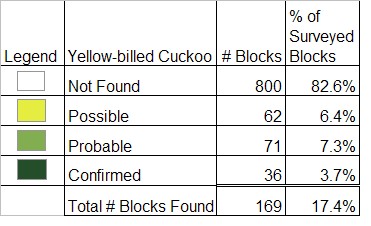Breeding Bird Atlases (BBA)
Find a Bird - BBA1
Breeding Bird Atlas 1 Species Accounts
Yellow-billed Cuckoo
Coccyzus americanus
Egg Dates
May 20 to July 9
Number of Broods
one

The Yellow-billed Cuckoo is an uncommon migrant and an uncommon to rare and irregular summer resident. During peak years of Tent Caterpillar, Gypsy Moth, and Fall Webworm infestations, cuckoos become more numerous because as a general rule they are the only birds that will eat large numbers of these caterpillars. Yellow-billed Cuckoos are found in moist thickets, overgrown pastures, orchards, willow and alder groves, and, like the Black-billed Cuckoo, they are regularly encountered in deciduous forests. Yellow-billed Cuckoos are more numerous in eastern Massachusetts and the Connecticut River valley and are rare or absent from much of the hill country of central and western portions of the state.
In spring, the first individuals are usually reported during the first week of May, but the general arrival does not occur until later in the month, and some migration is still continuing in the first week of June. Because cuckoos are skulkers, they are much more often heard than seen. Their voices have ventriloquial qualities, so one may think the bird is far off when it is actually on a limb close by. Knowing the songs of the two cuckoo species may be vital to identification. Whereas the commoner Black-billed Cuckoo’s notes are generally a series of cu-cu-cu notes, the Yellow-billed Cuckoo typically gives a louder and throatier kow-kow-kow series. Two good renditions of the yellow-billed’s song are: kakakakakakaka-ka-ka-ka-ka-ka-ka, kow-kow-kow-kow-kow-kow and kuk-kuk-kuk-kuk-kuk, ceaow-ceaow-ceaow-ceaow, slowing toward the end. There are a variety of other calls, including coo-coo notes, some of which are impossible to distinguish from those of the Black-billed Cuckoo.
Yellow-billed Cuckoos will never win a prize for nest building, ranking, in fact, near the bottom of the ladder. The nest is typically a flimsy saucer of twigs, with perhaps a few leaves added for a lining, placed from 2 to 12 feet high in a bush or small tree. Five Massachusetts nests ranged from 2 feet up in low bushes to 12 feet up in an oak sapling in a swampy thicket (ACB). In another sample of state nests, 1 was located at 5 feet in a Red Cedar near a swamp, and the others were all lower in thickets along brooks (ACB).
Two to four bluish green eggs are the rule. When more have been found, the suspicion is that a second female has dumped her eggs in the owner’s nest. Eggs may also be left in nests of the Black-billed Cuckoo, as well as a variety of other species. The clutch sizes for 3 state nests were two, three, and four eggs respectively (EHF, DKW). Massachusetts egg dates have been recorded from late May to early July; but in some seasons nesting may be delayed, and the actual range of dates probably extends through August. One brood per year is the rule, and, although there are no records of renesting, this could occur. Incubation, shared by both sexes, takes approximately 14 days, and, because it may begin before the clutch is complete, may result in a brood of young of different ages. Because the nest has been so sloppily built, it is not unusual for a young nestling to fall, with fatal results. The development of the young is similar to that of the Black-billed Cuckoo (see account for that species). Nestlings have been recorded in Massachusetts from June 3 to July 8 (TC, BOEM, Meservey), and an adult with four fledged young was observed on July 5 (TC). Again, more data is needed to determine the actual range of dates. Immature birds have somewhat duller plumage, but the rufous primaries are still diagnostic.
The timing of fall migration varies. In some years, Yellow-billed Cuckoos pull out by late July or early August, but usually the records are from mid-August to mid-September. There are October reports, and stragglers have been observed even in November and December. After fall hurricanes, there may be a reverse migration of Yellow-billed Cuckoos from the south. The species winters in South America, from Venezuela, Colombia, and Ecuador south to Argentina.
Map Legend and Data Summary
Atlas 1 data collected from 1975-1979


Note: uncommon in second-growth woodlands and scrubby areas
Henry Wiggin



